A Journey of 44 Months: Tribals of Boriguda Claim their Rights to their Forest Land
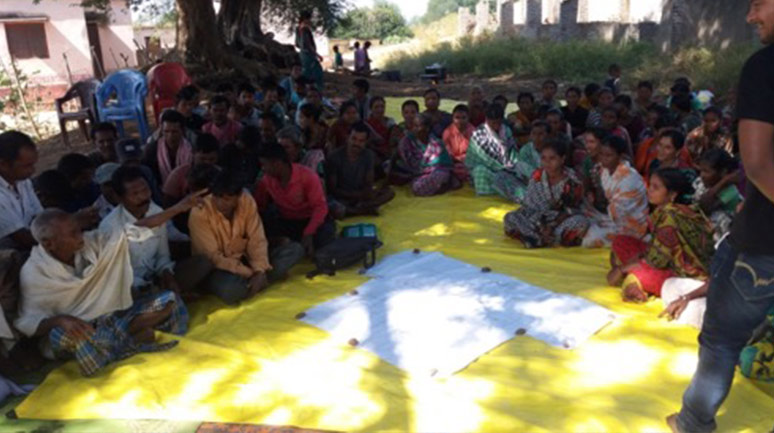

Concept Sharing on FRA and Land Rights in Boriguda village, Rayagada district, Odisha
Understanding the Forest Rights Act, the villagers of Boriguda, led by the women members of the SHGs there, have begun the process of claiming their rights to the forest lands, on and near which they have been living for centuries
T he injustices meted out to the traditional forest dwellers, including the forest-dwelling Scheduled Tribes (STs), has a historical context. Despite their essentiality in the survival and sustainability of the forest ecosystem, they have not been granted forest rights to their ancestral lands. Moreover, their habitat did not attract adequate recognition in the consolidation of state forests not only in the colonial period but also in Independent India.
The Scheduled Tribes and other Traditional Forest Dwellers (Recognition of Forest Rights) Act, 2006, or the Forest Rights Act, as it is popularly known, was crafted in 2005, with its enforcement taking place in 2006. Despite its aim to provide redressal to forest dwellers, who have been subjected to various injustices, and besides advocating transparency and efficiency in the conservation of forests, it did not achieve its full potential. Even after 14 years, a multitude of dwellers are still unaware of the provisions of the Act and the Act itself whereas some are exhausted by the rigorous processes involved in implementing the Act.
We are four sisters and we do not have any male member in our family. After the marriage of my younger sisters, I was left at home to take care of my widowed mother. If I do not have anything in my name, no one will take care of me in my old age. This is not in my case only. Ten other women in our village are facing the same problem. - Sabitri Hikaka
President of FRC, and a single woman)
This article captures the journey of a tribal village, Boriguda, supported by PRADAN, which witnessed a women’s-led struggle for Individual Forest Rights (IFR) and Community Forest Rights (CFR). Boriguda is a model village in Therubali gram panchayat of Kolnara block in Rayagada district, which lies in the south Odisha. Boriguda has 75 households belonging to the Kandha tribe. The tribals of Boriguda had been cultivating in the forest land for ages. As per government records, 105 acres of individual land and 208 acres of common forest land have been encroached upon by the villagers. As per the FRA, the land should be under the ownership of the tribal farmers, who have been cultivating and protecting the forests. In 2016, Boriguda, led by its women SHG collectives, took the road less travelled, to claim their right to the forest land.
Even after 14 years, a multitude of dwellers are still unaware of the provisions of the Act and the Act itself whereas some are exhausted by the rigorous processes involved in implementing the Act
The Beginning
The process of getting secure forest land rights was initiated in May 2016, with PRADAN and Landesa (a charitable organization, which partners with governments, communities and other stakeholders to advance pro-poor, gender-sensitive land rights reforms, using law and policy tools) conducting the first concept sharing meeting on women’s land rights in Boriguda village. A multitude of meetings took place, wherein all the villagers participated, bringing to the forefront various issues—land ownership; who is entitled to land rights; can women have the right to the land, etc. The villagers shared that a few of them had applied for land rights and nothing happened.
They also feared that if they pursued with asking for forest land rights for themselves, the government would push them back from the lands they are cultivating at present. As per government records, these are encroached lands and the people do not have records of owning the land although they have been cultivating these lands since time immemorial. They worry about harassment by the forest department. PRADAN and Landesa aimed to resolve some of these challenges by holding meetings, in which they would be educating the villagers, providing clarity regarding IFR and CFR, and addressing these issues.
I separated from my brother because of some family problem. Now I stay alone. Today, I have the strength to work for my food and survival. In my old age, when I am unable to do so, no one will offer me food if I do not have any property in my name. For this, I claimed my share of land separately.” - Lachi Kadraka (unmarried single woman)
Developing an Understanding of FRA
At first, awareness was generated on secured and unsecured lands. Villagers were asked to identify whether they have any secured or unsecured lands. ‘Secured’ land implies that the possession holder’s name is in government record books; second, the person has a document of possession and, third, the landholder/owner is in actual possession of the land. Absence of any of these three will make the land ‘unsecured’. The villagers identified that of the 332 acres of cultivated land, around 105 acres were unsecured.
PRADAN professionals and the Landesa staff held programmes for the villagers on Forest Rights. The villagers were informed about the IFR and the CFR Acts, the process of raising claims, and the role of institutions such as the palli sabha and the Forest Rights Committee (FRC). Besides, they were told about the responsibilities of the women’s collectives and how villagers can play an active role in the claim-raising process and later in the CFRMP.
FRC Formation and Training of FRC Members
One of the important steps in the forest rights claims-generation process was the formation of the FRC. Although there was an existing FRC, it was non-functional; therefore, it was decided that the FRC would be reconstituted. Because women had played an active role in the acquisition of the titles of homestead lands, with the support of the women’s Federation in Rayagada, it was decided that women should become members of the FRC. A palli sabha was organised for the reconstitution of the FRC and a 15-member FRC committee reconstituted. The Committee has 8 women members and its President is a woman. The process took place on 21 October 2016, in the presence of the panchayat Sarpanch and panchayat Extension Officer. The information about the formation of the FRC was dispatched immediately to various departments and stakeholders, including the panchayat, the Welfare Extension Officer (WEO from ITDA), the Block Development Officer (BDO), the Tehsildar (Revenue Department) and the Forest Ranger and District Forest Officer (DFO).
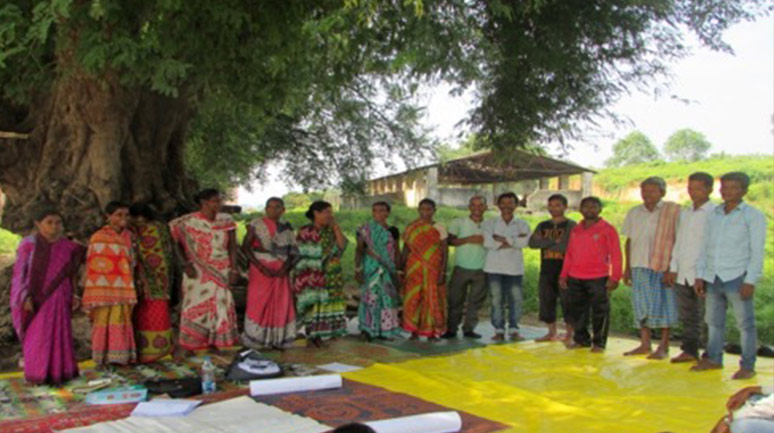
Reconstitution of the FRC in the Palli Sabha
This was followed by a 4-phase training programme, conducted by PRADAN, and it incorporated various central-level training programmes by members of the Committee. Resource persons from different organizations such as Foundation for Ecological Security (FES) and Landesa were invited to impart training on the Acts and the laws related to FRA, as well as the duties and responsibilities of the members of the FRC.
Because women had played an active role in the acquisition of the titles of homestead lands, with the support of the women’s Federation in Rayagada, it was decided that women should become members of the FRC.
IFR Claims-generation Process
The process of preparing IFR claims was initiated by individually identifying every household of the village, including those of single women. As per the norm, there was to be 100 per cent saturation, by which no family would be excluded; 75 households were identified, of which 11 were that of single women. After the households were identified, the village selected one educated person to be the technical resource person, called Jami Sathi. The role of the Jami Sathi is to support the villagers to measure their land, calculate the area and help in filling the claim form. The whole process took three weeks to complete. For all this work, the Jami Sathi was paid by the villagers. A retired revenue inspector was also hired, who trained the Jami Sathi because the trace maps submitted earlier were rejected. The Jami Sathi was taught how to do land markings and measurements, using measuring chains. The Jami Sathi also learned about the scale and unit of the trace map, and the use of the compass. These measurements were further validated by a digital map, prepared using a GPS-enabled Smartphone.
During the entire process, women played an active role and supported the Jami Sathi. Affirmative action was taken by the villagers of Boriguda. In the claim form, they enlisted the woman as the head of the family and put the husband’s name in the ‘Spouse’ column.
After the IFR claim process, the villagers started with the CFR claim preparation. The process required the involvement of all the villagers and the people from those neighbouring villages, which shared a common boundary with Boriguda village. The CFR claims preparation process began at dawn, with the villagers marching towards the boundary of their village with axes, ropes, some flags and measurement chains. The neighbouring villagers were informed beforehand about the process. Thus, with the consent of the respective villages, the traditional boundary was finalized and marked. To make the survey accurate, triangulation was done, using the survey chain from different reference points. To avoid future complications, the geo-coordinates of these boundaries were also taken and a geo-referred map was prepared.
Last time, a person came and filled the application for us. We didn’t know where he had submitted our claim or what he had written in the claim. This time, each villager understood what she/he was doing and why. The decisions were taken in a common forum and we kept motivating each other to move forward,” - Parshu Hikaka, Treasurer, FRC, Boriguda
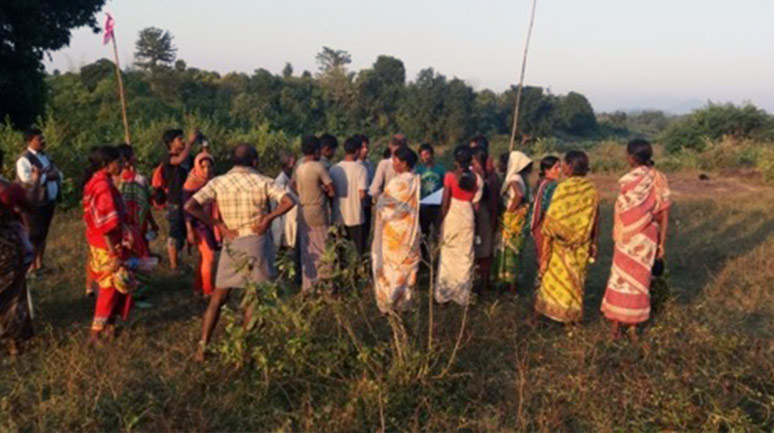
Identifying the Areas for Claiming CFR
The satellite view from the GPS map was referred to for both IFR and CFR, so as to be doubly sure about the readings. From the map, it was very obvious that villagers’ economy depended heavily on forest land. At the end of the survey, the total land claim for IFR was 105 acres and for CFR was 208 acres.
Joint FRC Meeting with the Neighbouring Villages
On 17 November 2016, the villagers of Boriguda and seven neighbouring villages conducted a joint FRC meeting to finalize the traditional boundary for their CFR claim. The event was graced by the senior citizens of all villages and the details were read out. An agreement was reached that the eldest people in the village would sign the document so that there is no tussle in the future between two villages sharing a boundary and the resources within the boundary. The document then was placed as proof in government records.
Verification Process with the Departments
After the joint meeting, the FRC finalized all the documents and presented the final list of claimants and their area of occupancy to all villagers. From the feedback of the villagers, the FRC corrected some minor mistakes and finally deposited its claim to the government in February 2017. No action was taken by the administration for almost a year. In February 2018, on behalf of the village, the FRC President filed an RTI in the name of the Sub District Level Committee (SDLC), the Welfare Extension Officer (WEO) and the forest department, to know the status of their claim. This intervention resulted in the first joint verification in Kolnara block, in which the palli sabha issued the joint verification notice.
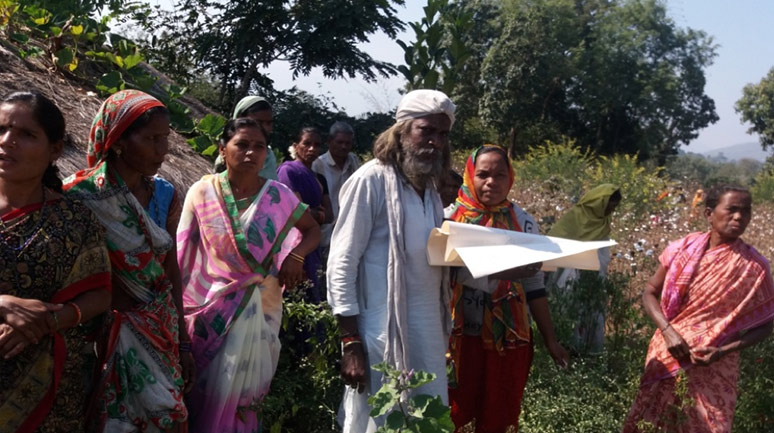
Amina (please say who she is) Validating the Villagers’ Measurement of IFR Plots in Boriguda
Finally, after one year, the joint verification process was carried out in the presence of the revenue, the tribal and the forest departments. The marked area in the village was not in the reserve forest; therefore, there was no objection from the forest department. The revenue department, however, deployed its amina (an employee who measures the land) to demarcate the land for revenue certification. When demarcating the lands and identifying government plots, several challenges came to light; for example, an encroached plot of one person was recorded as two different plots in government records; some areas from the government land in Boriguda village had been issued to outsiders; and some plots were reserved for departmental use. However, none of the above was mentioned in the online land portal, referred to by the villagers. And because of these discrepancies, the revenue department did not give its approval.
Affirmative action was taken by the villagers of Boriguda. In the claim form, they enlisted the woman as the head of the family and put the husband’s name in the ‘Spouse’ column.
There were tensions in the village and the villagers also blamed the SHGs for putting them in such a situation. The worried villagers feared that nothing would happen and that the government would take away the lands on which they were cultivating. It took a great deal of effort to convince the farmers and start the process again. The SHGs organised meetings with all the villagers to resolve these issues. There were a few people whose land was disputed or was marked as reserved land by the revenue department. To compensate this, the villagers decided to re-allocate some land to these villagers by giving them a part of their own land and by allocating to them some of the barren land that was not under anyone’s possession. The entire documentation process was done again and fresh documents were submitted to the department for approval.
Approval from the District-level Committee: An Arduous Journey
Once there was approval from the revenue and the forest departments, the FRC submitted 75 IFR and CFR application with all the required documents and trace map to the WEO office. The WEO office is supposed to check the records and pass it to SDLC for final approval. The documents were submitted to the WEO in May 2019 and it took another eight months of arduous follow-up for the file to reach the SDLC table.
In the FRA guidelines, the claims-generation process mentions that once the WEO goes through the file, there are only two steps—approval by the SDLC and then by the DLC. Nowhere does it mention that the file has to pass through number of offices from the WEO to the SDLC office. Our experience in Boriguda was, however, different. Listed here are the different stages in the progress of the file.
| i | Submission of Claim to the WEO |
| ii | WEO transfers the claim to the BDO. |
| iii | BDO hands over the claim to the tehsildar. |
| iv | The tehsildar hands over the claim to the RI |
| v | Certification by the RI |
| vi | RI reverts the claim to the tehsildar |
| vii | The tehsildar reverts it to the BDO |
| viii | BDO sends it to the Forest Ranger Office for verification. |
| x | Forest Guard prepares a trace map if the reserve forest is claimed |
| xi | Forest Guard sends it back to the Forest Ranger |
| xii | Forest Ranger certifies the claim. |
| xiii | Forest Ranger reverts it to the BDO |
| xiv | The BDO forwards it to the WEO |
| xv | The claim passes to the SDLC office |
Finally, in December 2019, the claims were sent from the block to the SDLC, which gave its approval on 22 January 2020. The FRC deployed an educated youth from the village at the SDLC office to support the filing process for each claimant.
Taking stock of the present file location, and engaging with the concerned officer to complete the required task and move the file forward is one of the major interventions by PRADAN and the community. In this process, necessary templates have been developed to aid different officials and speed up the process. Now, these templates are used by these officials to forward other forest right claims.
The villagers have plans to create different structures, for instance, farm ponds, check dam rings, land levelling through MGNREGA. SHGs are also collecting local seeds to plant in the CFR areas. This will not only enrich the forest but will also impact the livelihood of the village directly, by making available NTFP products, and indirectly, by creating grazing areas for the livestock.

Amina (please say who she is) Validating the Villagers’ Measurement of IFR Plots in Boriguda
Approval of FRA
At last, on 29 January 2020, the claims got approved by the DLC. The women were overjoyed to receive the news of the approval; that day, the village organised a festival in the name of their jhakiri (forest goddess). The villagers of Boriguda have now paved the way for others in the district. Finally, after an arduous journey of 44 months, they experienced some satisfaction. This is the first time that the approval of IFR and CFR has happened for the entire village. Of the 75 IFR, 11 IFR are of single women. All will not be over till they are handed the titles to their land. The struggle lingers.
It was in the 1980s that about 10 families received 2 acres of land. The rest of us remained landless. We were cultivating the forest land but lived with the fear that we would not be able to cultivate it the following year. Now, we have our land. We have gone through a process, and our journey, though difficult, gave us many insights. We now guide other villagers on how to get their FRA.” - Trinath Huika (Jami Sathi)
Worth mentioning here is the fact that the villagers bore all the costs such as fees of the Jami Sathi for documentation, travel, and lodging and boarding, and of the youth deployed at the SDLC office. The total cost incurred by the villagers was Rs 50,000. And the detail of each transaction was recorded in a register.
There is a plan to create a bank account for village forest conservation and village development. The role of the SHG as an institution, in keeping the villages united and giving direction to overcome hurdles, cannot be ignored in the whole process. With the approval of the titles, a cluster river lift project got sanctioned by the Odisha Lift Irrigation Project (OLIP), which will ensure year-around agriculture. The villagers have plans to create different structures, for instance, farm ponds, check dam rings, land levelling through MGNREGA. SHGs are also collecting local seeds to plant in the CFR areas. This will not only enrich the forest but will also impact the livelihood of the village directly, by making available NTFP products, and indirectly, by creating grazing areas for the livestock.
A Glimpse of the IFR and CFR Claim Process in Rayagada District, Odisha
| No | particulars | Quantity (No.) |
| 1 | Villages of Kolnara, where PRADAN engaged in FRA | 33 |
| 2 | IFR claims submitted to Block Nodal (WEO) | 1,030 |
| 3 | CR & CFR claims submitted to Block Nodal | 21 |
| 4 | Total IFR area claimed in acres | 866 |
| 5 | Total CFR area claimed in acres | 5,837 |
| 6 | Local cadres (Jami Sathi) groomed for process facilitation | 5 |
Learning points for the facilitating agency
- Land, as a subject, is a conflicting topic. In PRADAN, we had not directly worked on land rights; our intervention focused on supporting the livelihoods of families. Issues of land ownership are complicated. There will be conflicts, there will be fights, it will attract political influence, people will threaten, and there will be divisions, with the villagers supporting different persons. Irrespective of the context, the facilitator needs to be patient, respect each decision of the community and maintain complete transparency.
- Creating awareness around FRA and the process involved: Before proceeding, the community members need to be thoroughly oriented about FRA and the processes involved so that they are prepared to handle challenges that come during the entire process. As mentioned earlier, there are delays by the departments; there is tussle and conflict among the villagers themselves because the matter is related to land.
- Training of local youth as Jami Sathi: Training Jami Sathis not only helps the particular village but also the nearby villages. There are five Jami Sathis now, who are helping the villagers to educate nearby villagers about the land and their rights. They are also helping different people to map their land, fill forms and write applications, to avail the homestead land. They are utilizing their expertise in nearby villages to raise IFR and CFR claims with proper documentation.
- Documentation: Initially, it was a big struggle to convince the department to refer to and consider the measurements and trace maps submitted by the villagers. This problem was solved when the services of a retired Revenue Inspector was taken. He not only helped in training the Jami Sathi on how to take standard measurements but also helped proper documentation and development of standard trace maps. He presented the case with the department on behalf of the villagers. This was an important initiative. The first joint verification took almost one year with the back-and-forth movement of files; however, now, because of meticulous filing and documentation, the process of joint verification is conducted within 15 days of the submission of a claim.
- Use of Technology: PRADAN carried out a pilot programme on the use of digital mapping of the land and the geo-tagging of cadastral maps in the village. The women and the youth of the village were taught how to use GPS, to locate and take coordinates. With the help of Cadasta ( https://cadasta.org/), a mobile application, which can store the data of the entire village and tag them with the plot number, was developed. Digital mapping of the CFR area helped influence the stakeholders such as the Integrated Tribal Development Agency (ITDA), the Sub-Collector and the forest department. Through digital mapping, villagers can identify the location of their land in different government plots. Digital marking has reduced demarcation time considerably. Manual measurement takes about three weeks; now, by using GPS, this has come down to 10 days.
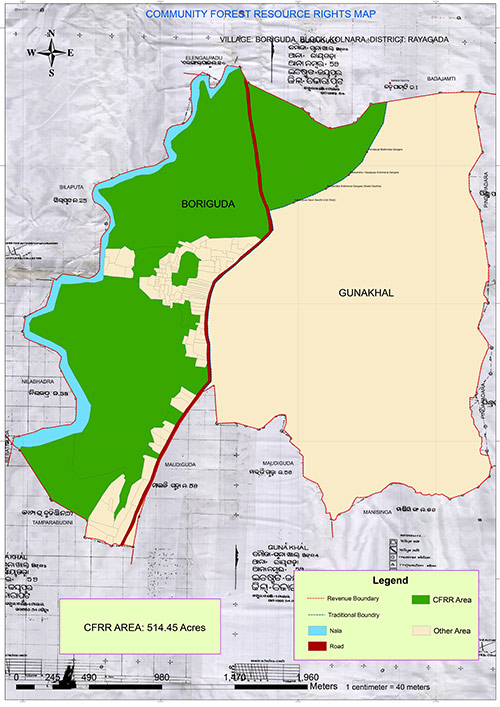
GPS Map Superimposed on the Revenue Map
Way Forward
Although the Act was crafted in 2006, its orientation is limited to A-grade officers, because of which the actual implementers, who the villagers encounter during the process, are unaware of the process. Panchayat representatives, who change every 5 years, need an understanding of these Acts for the successful grounding of the Act. Besides, there is a difference in understanding the Act and the words used in the Act, due to which misunderstandings often happen. Therefore, it is crucial that the government officials, panchayat representatives, FRC members and other stakeholders are oriented about the FRA guidelines. And the process of claim generation is well-articulated, decoded and simplified for both the claimants and the respective government departments.
For more publications, please refer to the following:
- Newsreach-May–June 2015
- Do Tribal Women Have Land Rights?
- Our Forests, Our Rights and Our Responsibilities


2 Comments
Really Amit you have done good job and captures so many things. This document gives an idea to know the processes of FRA implementation with a focus to women land rights. Thanks for your efforts.
Thankyou Jagdis Bhai.
It was an opportunity to learn from you and translate the knowledge to practice.